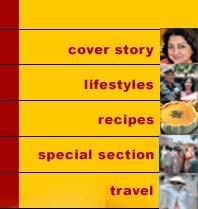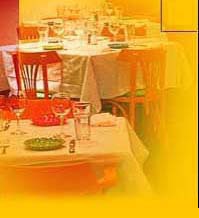


 Wine�s The Rage!
Wine�s The Rage!
UpperCrust checks out the local wine market and finds that the Indian wine drinker has become an aficionado if not a connoisseur yet, and that Indian wines have come of age. |
|
There can be no doubt that Indian wines have of come of age. And that we are a fairly young wine-drinking nation. The afternoon UpperCrust�s Farzana Contractor took foodie Karen Anand to Vetro at The Oberoi, to check the impressive wines the new Italian restaurant�s wine bar keeps, Mark Manuel was looking at the same bottles at Peekay Wines in Bombay. �They are all available here but for a price,� said the Irani wine merchant. �You can buy a bottle of Moet for Rs. 3,438, Dom for Rs. 9,050, Michael Laroche�s Chardonnay from France for Rs. 635, the Soavoeclase white from Italy for Rs. 1,083, the Hardys , Howling Wolves, Jacob Creek and Yellow Tail range of wines from Australia for between Rs. 700 and 900, Californian Merlot and Chardonnay for Rs. 1,170, Germany�s Maybach Reisling for Rs. 500, and there are wines from South Africa, Chile, Spain, and Portugal as well.� A customer came up and asked for a bottle of Beaujolais costing Rs. 955. The wine merchant sniggered, �Foreign wines sell. The corporate sector buys more of these than the individual. But Indians are slowly becoming wine aficionados. Two years ago, people could not pronounce the names of these bottles, but today they are discerning, they don�t just ask for a bottle of red or white wine but they are specific about what wine they want and from which region it must be. The wine scene has exploded. Our sales have gone up by 200 per cent!�
Hard on Chougule�s heels was Kanwal Grover who started in the Nineties and today has six very saleable wines in the market of which his La Reserva red wine and Viognier-Clairette are best sellers. Grover also has the legendary Michel Rolland making wine for him. And Rolland of Bordeaux is known around the world as the flying wine-maker because he reportedly takes an international flight every two days to some wine-making nation where he is the consultant. The third big player on the domestic wine scene and a late entrant at that, is Sula Vineyards in Nashik of Rajeev Samant. Sula, in commercial terms, is India�s great wine success story. Dr. Aakash Singh Rathore, who wrote The Complete Indian Wine Guide, says, �Sula is all about good marketing. Their labels are attractive, their bottles/corks are good, their owner is a media charmer.� Under Californian wine expert Kerry Damskey�s guidance, Samant began to not only produce what is regarded as some of India�s best wines, but he also initiated an import variety of great regime. Damskey gave Sula its fairly outstanding Sauvignon Blanc and its hugely successful Chenin Blanc. Additionally, Indage and Sula have a range of imported wines bottled in India which often go under the name �joint venture� wines. Basically, these are wines imported in bulk, generally in huge tanks or vats, and then bottled and labelled in India to reduce the duties paid on imported wines, permit the sale of imported wines in certain regions where not bottled in India wine cannot be sold in shops (like Delhi) and create a label that appeals specifically to the Indian market. These JV wines are generally more expensive than the Indian produced wines. Indage has eight JV wines from Australia, South Africa, France, Germany and Chile including the impressive Cranswick range from Australia; Sula has two, a white Pacifica Chardonnay from California and a Satori Merlot from Chile. But that is just the start. There must be over 250 types of international wines available in India and some 75 types of wines produced by 20 major domestic wine production companies throughout India. These include names like Bluefolds, Dajeebah, Flamingo, Greno, N.C. Fine Wines, Prathamesh Wines, Princess, Pyramid, Rajdheer, Saikripa, Sailo and Vinsura. �The expats buy them because they are looking at good table wines to have with every meal. And the Indian wines are VFM,� said the Peekay Wines merchant.
Karen Anand on cooking with wine There is nothing mysterious or complicated about the use of wine in cooking. The cardinal rule is never boil wine or a wine reduction. When adding to classic French stews like Coq au Vin (chicken cooked in red wine) or Boeuf Bourguinon (beef cooked in Burgundy), you add a generous amount of wine which slow cooks along with the meat, thereby tenderizing it as well as flavouring the dish. In the case of pan frying, like the classic Tournedos Rossini (steaks with foie gras and a red wine sauce), the reduction is made in the pan after the beef is cooked or added in the form of a demi glace ( a thick sauce made with wine which is heated, simmered and reduced to increase the concentration and to which veal stock and shallots are added. No flour is necessary). Although white wines and Sherry are generally used to flavor seafood and dishes containing white meat, as well as cheese dishes, cream soups and light sauces and red wines are used for red meats, ragouts and more robust sauces, there is no hard and fast rule. I have tasted fish and chicken dishes cooked in red wine and chicken also cooked in Marsala, a dry sherry from Sicily. Although I suppose you can use wine to flavour vegetables, there is no history behind this. Vegetarians will have to be content with some great desserts like Poached Pears in Red Wine or Figs in Red Wine & Tea. Some people mistakenly believe that if you are preparing a very elegant dish you should use expensive vintage wine. Not so. You can use an expensive wine to drink with it but it is a bit of a waste to cook with it. Having said this, a bad wine will definitely produce a bad dish. If you use wine which has been lying around for months and has almost turned to vinegar, please throw it away. The function of wine in cooking is to intensify, enhance and accent the flavor and aroma of food. This is not going to happen if you add vinegar! The reason for this is very simple. The delicate flavors of a premier grand cru Bordeaux or a great Burgundy will be utterly lost in the cooking process. What is required for cooking is a good wine, to be sure, but one that is robust enough to retain its essential flavors after a heat treatment. Wine undergoes a transformation when it is heated. During the cooking process the alcohol is evaporated and wine changes character depending upon the amount of heat to which it is exposed and the length of the cooking time. A wine that is simmered for a short time over low heat will have a different flavour than the same wine subjected to high heat over an extended period.
|

Home Page
About the mag
Subscribe
Advertise
Contact Us
 It is true. Gone are the days when the only wine that was available in India was an appalling ruby red Golconda produced by Shaw Wallace. Which even then was no match for the ghastly red, white and a Sherry produced by Bosca Wines of Baramati. Dr. Ivo Azaredo Costa of Goa, who pioneered the business of cold storage meats, came out with two reds and whites and a port under the label Vinicola that still continue to sell, though these wines are used mainly by small restaurants as cooking wine. Then, of course, came Shamrao Chougule who grew the finest French wines in the sharp, flinty fields of Maharashtra and had the gumption to send his Narayangaon wines into the heart of France and sell them there. Which is more than just taking coal to Newcastle, this is like the French making zunkha bhakar and selling it in Maharashtra. It was not as easy as selling Basmati rice or Alphonso mangoes, but Chougule managed, and he paved the way for other Indians to follow. In the process, Chougule�s Chateau Indage also managed to come up with several more wines, notable among which are his varietal vintage wines (made from one specific grape varietal like, say, Chardonnay) which are marketed under the brand name Ivy and include a Viognier, Semillon-Chardonnay, Shiraz, Zinfandel Malbec and Chenin-Muscat. In addition, of course, to Chateau Indage�s varietal non-vintage wines under the Chantilli and Riviera range, all of which are affordable and good table wines.
It is true. Gone are the days when the only wine that was available in India was an appalling ruby red Golconda produced by Shaw Wallace. Which even then was no match for the ghastly red, white and a Sherry produced by Bosca Wines of Baramati. Dr. Ivo Azaredo Costa of Goa, who pioneered the business of cold storage meats, came out with two reds and whites and a port under the label Vinicola that still continue to sell, though these wines are used mainly by small restaurants as cooking wine. Then, of course, came Shamrao Chougule who grew the finest French wines in the sharp, flinty fields of Maharashtra and had the gumption to send his Narayangaon wines into the heart of France and sell them there. Which is more than just taking coal to Newcastle, this is like the French making zunkha bhakar and selling it in Maharashtra. It was not as easy as selling Basmati rice or Alphonso mangoes, but Chougule managed, and he paved the way for other Indians to follow. In the process, Chougule�s Chateau Indage also managed to come up with several more wines, notable among which are his varietal vintage wines (made from one specific grape varietal like, say, Chardonnay) which are marketed under the brand name Ivy and include a Viognier, Semillon-Chardonnay, Shiraz, Zinfandel Malbec and Chenin-Muscat. In addition, of course, to Chateau Indage�s varietal non-vintage wines under the Chantilli and Riviera range, all of which are affordable and good table wines.
 Michel Rolland
Michel Rolland Kapil Grover
Kapil Grover Ranjit Chougule
Ranjit Chougule Rajeev Samant
Rajeev Samant Asit Chandmal
Asit Chandmal